Did you know that poppies can be annual or perennial flowers? In fact, oriental poppies, alpine poppies, and Iceland poppies are all perennials.
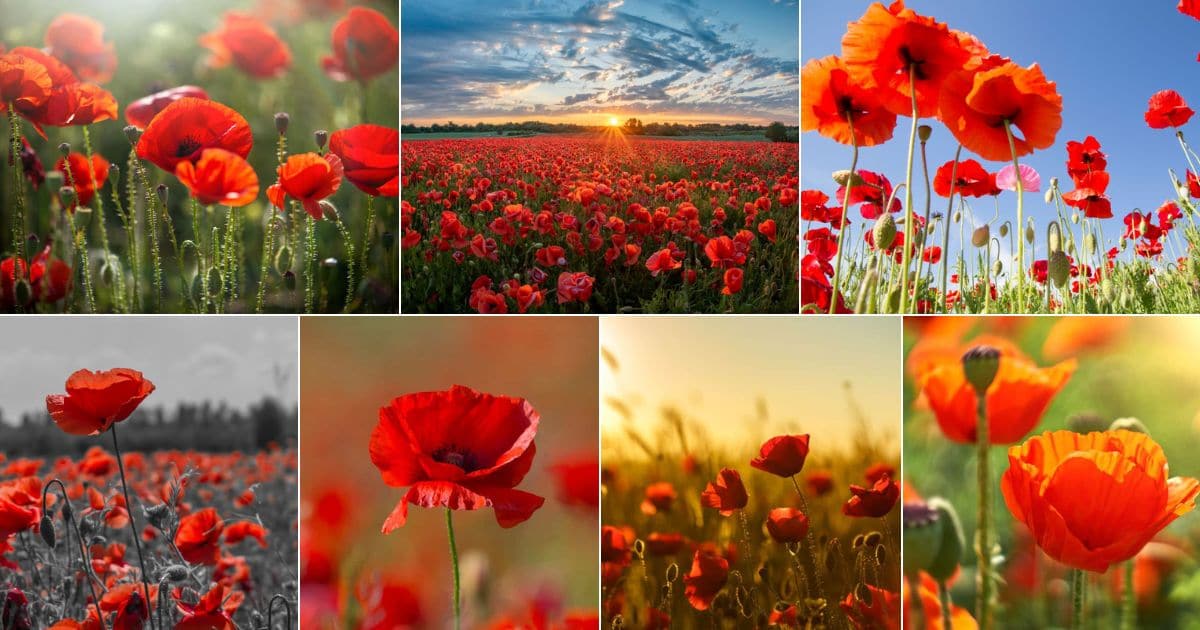
In this guide, we will tell you everything you need to know about growing poppies, with a focus on perennials that blossom multiple years.
Use the table of contents below to jump right to the section you are interested in, or read through our full guide to learn all you need to confidently get started with perennial poppy gardening!
Jump to:
- What Are Poppies?
- Are Poppies Annual or Perennial Flowers?
- Poppy Basics
- Where Do Poppies Grow?
- Why Grow Poppies?
- Poppy Landscaping Ideas
- Recommended Poppy Varieties
- When Do Poppies Bloom?
- How Long Do Poppies Bloom?
- When to Plant Poppies
- Ideal Growing Conditions for Poppies
- How to Plant Poppies
- How to Care for Poppies
- How to Transplant Poppies
- How to Propagate Poppies with Cuttings
- Recommended Companion Plants for Poppies
- Frequently Asked Questions About Growing Poppies
- Where to Buy Poppies
What Are Poppies?
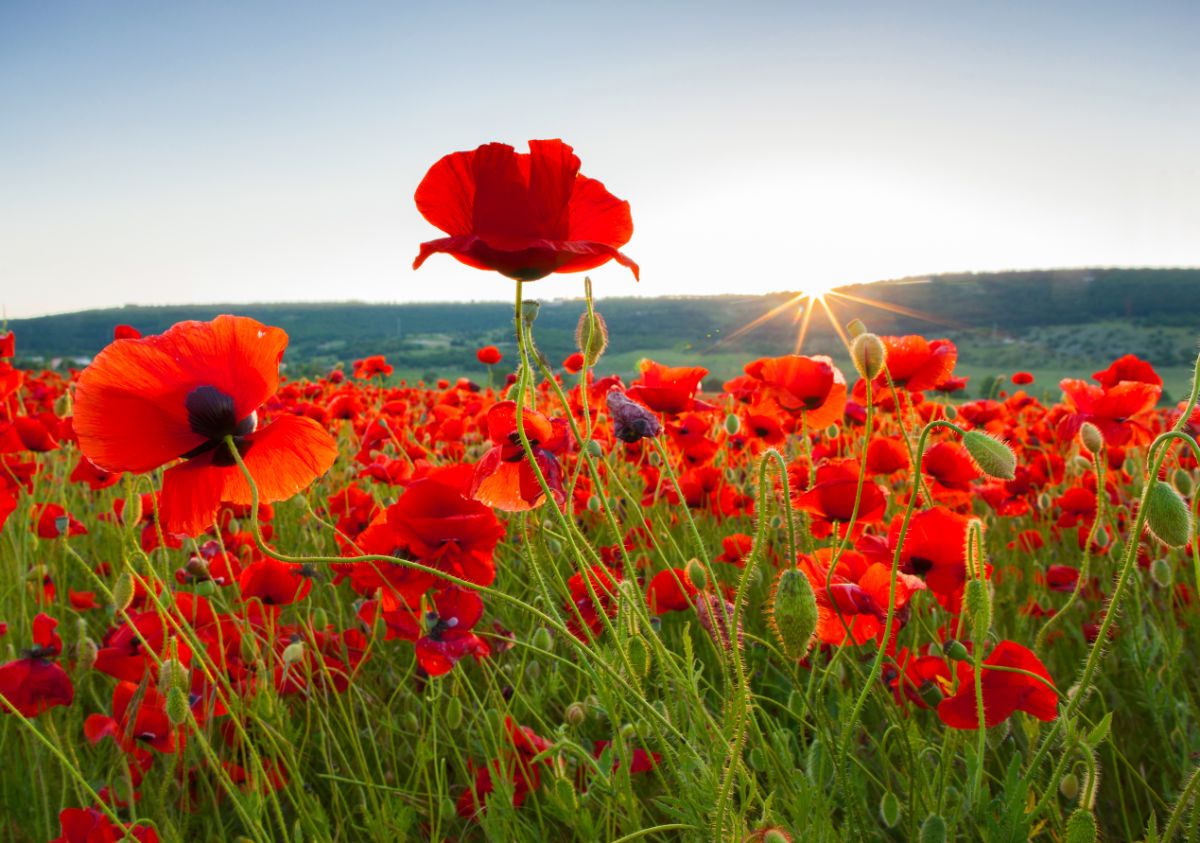
When you see the orange or yellow petals of poppies, they seem to catch the sun itself, holding it within their blossoms.
You probably can recognize poppies when you see them, but how much do you know about these cheerful flowers?
Poppies are defined as herbaceous plants in the Papaveraceae family and the Papaveroideae subfamily.
There are quite a few different types of poppies. While the majority are the familiar colors of red, orange and gold you probably associate with poppies, they can come in other colors too.
Some types of poppies include oriental poppies, wind poppies, prickly poppies, celandine poppies, and others.
There is, of course, also the opium poppy, Papaver somniferum. As suggested by the common name “opium poppy,” this is the type of plant that can be used in opium production.
That said, people also grow it to harvest poppy seeds for regular culinary use. Sometimes, it also is called “breadseed poppy.”
Are Poppies Annual or Perennial Flowers?
You may have heard that poppies are annuals, but you might also have heard that they are perennials. Which is true?
The answer is “both.” Some poppies are annuals. Others are perennials, returning several years in a row. Still others are biennials.
So, if you want the poppies you plant this year to bloom next year as well, it is best to shop for perennial varieties.
Poppy Basics
Zones: 2-9 (varies)
Blooming season: Late spring through early summer
Expected height: 6 inches to 3 feet (varies)
Soil: Well-drained soil
Sun: Full
Where Do Poppies Grow?
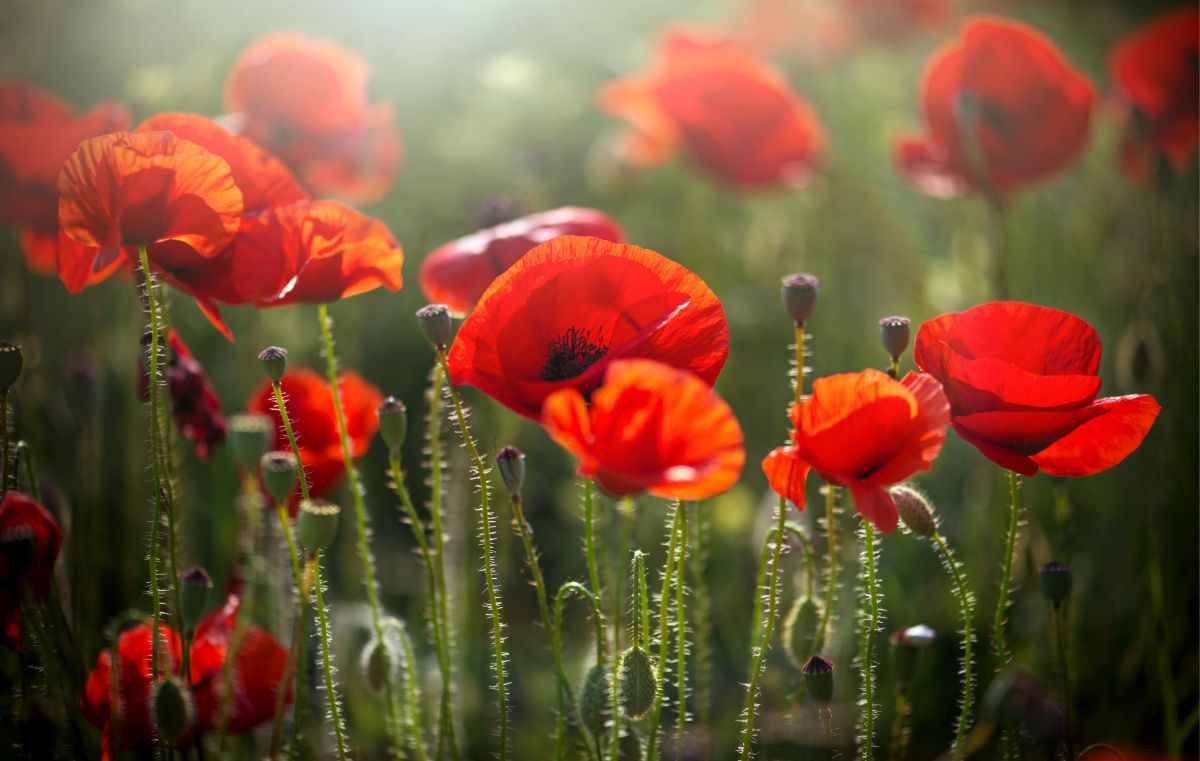
Poppies are native to Eurasia and North Africa. The Silk Road was the avenue through which poppies spread across a wide region. Poppies lost some of their popularity during the 20th century due to regulators worrying that people might grow the plant to make opium.
Regardless, it is quite easy to come across poppy seeds for sale online or at your local plant nursery.
Why Grow Poppies?
- Poppies can grow in a range of soils and climate conditions. Because they adapt so well, they are easy to grow, even for novice gardeners. They can flourish in many different locations.
- Poppies are drought-tolerant plants. If you have hot, bright summers without a lot of precipitation, your poppies should be okay with appropriate watering.
- Deer and rabbits will probably steer clear of poppies in your yard. Although this is not a guarantee, there are a lot of other plants they find far more enticing.
- Snails and slugs do not like poppies much. Again, this does not guarantee that you will never have problems with them, but it is not too likely.
- The warm colors of poppies make your yard or garden look inviting. Not only will you enjoy them, but bees will delight in these blossoms as well.
- Poppy flowers do not require a lot of maintenance. They don’t need much water, you can usually skip deadheading them, you probably don’t have to stake them, and they generally are not too susceptible to disease or pests.
- Poppies self-seed. Regardless of whether you choose annual or perennial varieties, you should find that they spring up in your garden each year pretty reliably.
- It is really easy to propagate poppies using cuttings. So, that is an option if you want to take a more controlled approach than allowing them to go to seed.
- Poppy flowers are fleeting. Have you ever heard of the Japanese concept of Mono no aware? It can be translated roughly to mean “a sensitivity to ephemera.” It is essentially an appreciation for all that is beautiful and fleeting in life. It is one of the reasons cherry blossoms are so popular in Japan. Like cherry blossoms, poppies’ beauty is fleeting each year, and invokes a similar state of mind.
Poppy Landscaping Ideas
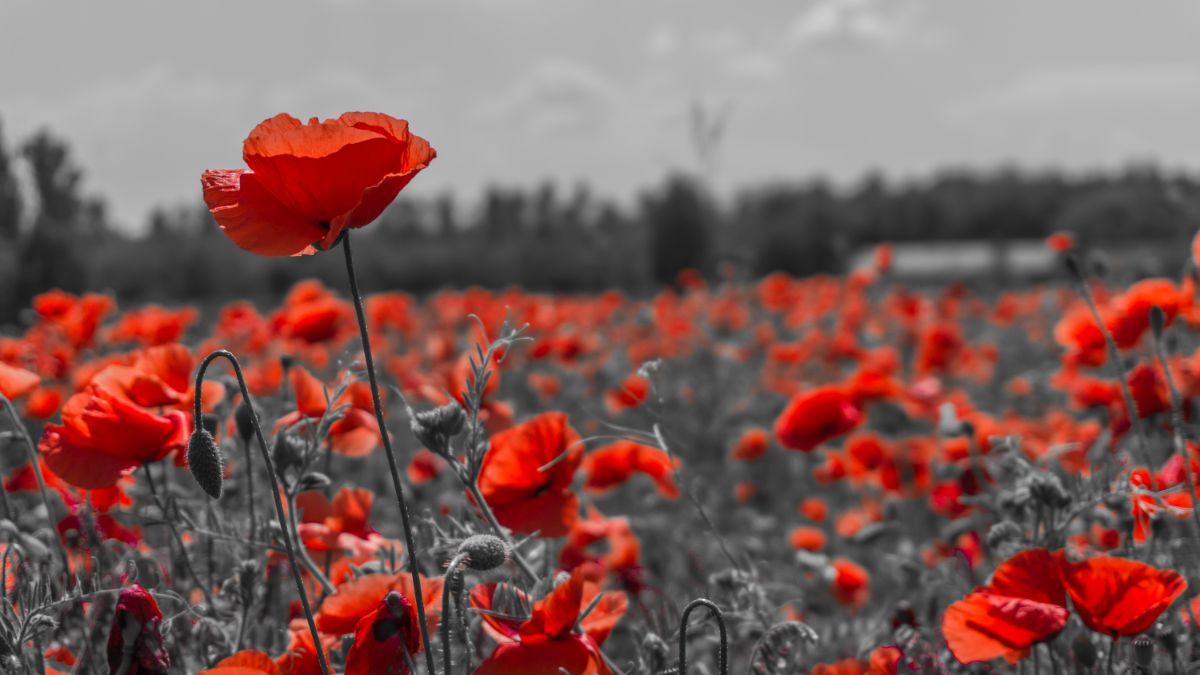
Here are a few ideas for how you can use poppies in your garden.
- A wildflower garden: It is common to find poppies growing out in nature in some locations, so you may enjoy the “wildflower” look that these blossoms bring to your garden. You can, in fact, plant them among other wildflowers to give your entire garden a natural look and feel. You might even find them as part of a wildflower mix for sale.
- A border: Did you know that you can plant poppies as a border? This flush of flowers will not be a tight, compact border, but it can highlight a path beautifully.
- A prairie garden: Poppies and other prairie flowers can thrive well together, especially if you are in a region where prairies are a natural landscape.
Recommended Poppy Varieties
There are numerous types of poppies out there, but since we are focused on perennials, we will just share some recommended varieties of Iceland and Oriental poppies below.
Iceland Poppy Cultivars
- Wonderland: When you plant this dwarf Icelandic poppy, you will swear you actually planted a whole heap of different varieties! They come in a range of hues: you’ll see everything from white to orange to red to yellow. Compact and cheerful, they will become the delight of your garden.
- Champagne Bubbles: This is another type of dwarf poppy to consider for your garden bed. The Icelandic poppy seeds will grow into lovely blossoms in white, orange, red and yellow. They are popular for lining paths.
- Party Fun: Another option for a riot of colors is the “Party Fun” variety. The surprising range of colors includes orange, white and red.
- Matador: Not surprisingly, this variety sports beautiful blood-red flowers with dark centers.
- Oregon Rainbows: As the name implies, the first location where these flowers were grown was Oregon. The beautiful flowers feature a variety of colors, making a lovely addition to your garden.
- Victory Giants: If you are in a cold location, you might consider planting “Victory Giants.” They also sometimes go by the name “Arctic poppies.” The bold flowers are showy, featuring petals that are orange, white, yellow, and cream.
- Summer Breeze Orange: Don’t want a mix of colors? You can get poppies that are all the same vivid hue of orange by getting this variety. They blossom longer than some other cultivars, and will light up your garden with their sunny hues around the start of summer. Although we are listing them among the other Icelandic poppies, a more appropriate classification is under interspecific hybrids.
Oriental Poppy Cultivars
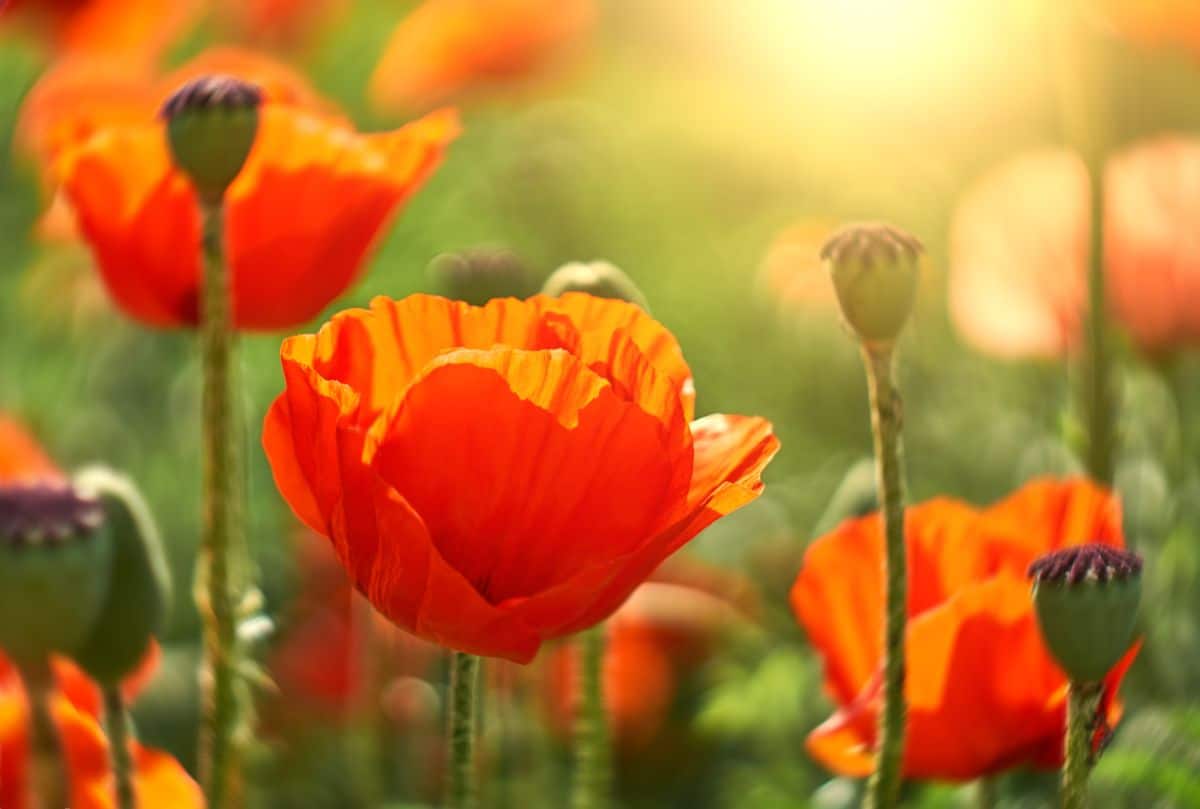
- Patty’s Plum: While most poppies are reds, oranges, yellows and whites, there are some poppies that are different colors altogether. One example is the striking “Patty’s Plum” cultivar of Oriental poppy, which features pink petals.
- Garden Glory: With its double blooms featuring ruffled petals, these might just be the prettiest flowers in your garden. The petals are a salmon hue.
- Beauty of Livermere: This popular variety of poppies features blossoms with bold red petals and dark middles. It is among the taller varieties of poppies as well, with heights up to 1 meter.
- Maiden’s Blush: The beautiful booms on this type of poppy have a particularly unusual color. They are a light salmon, making for a soft, romantic look.
- Turkenlouis: Here is another type of Oriental poppy that is red in color. The middles of these beautiful blooms are a deep purple shade. The fringed edges of the petals make for an eye-catching appearance.
- Avebury Crimson: The brilliant blooms of this type of poppy are a vivid scarlet.
- Manhattan: Another cultivar with brilliant blooms in pink is the “Manhattan” variety. These blossoms with dark middles make a big statement in keeping with their name.
- Wisley Beacon: For an Oriental poppy featuring brighter blooms in orange, you cannot go wrong with the well-named “Wisley Beacon.”
- Princess Victoria Louise: This cultivar can grow as high as 3 feet, and features large, showy blossoms in salmon.
- Fireball: Another option for an orange Oriental poppy is the “Fireball” cultivar. Choose this variety for something compact. Blossoms can be single or double.
When Do Poppies Bloom?
Oriental poppies bloom in spring and early summer. Alpine poppies usually bloom in summer. Iceland poppies are spring-blooming flowers.
So, you might want to plant more than one type of poppy. Doing so will extend your bloom season.
How Long Do Poppies Bloom?
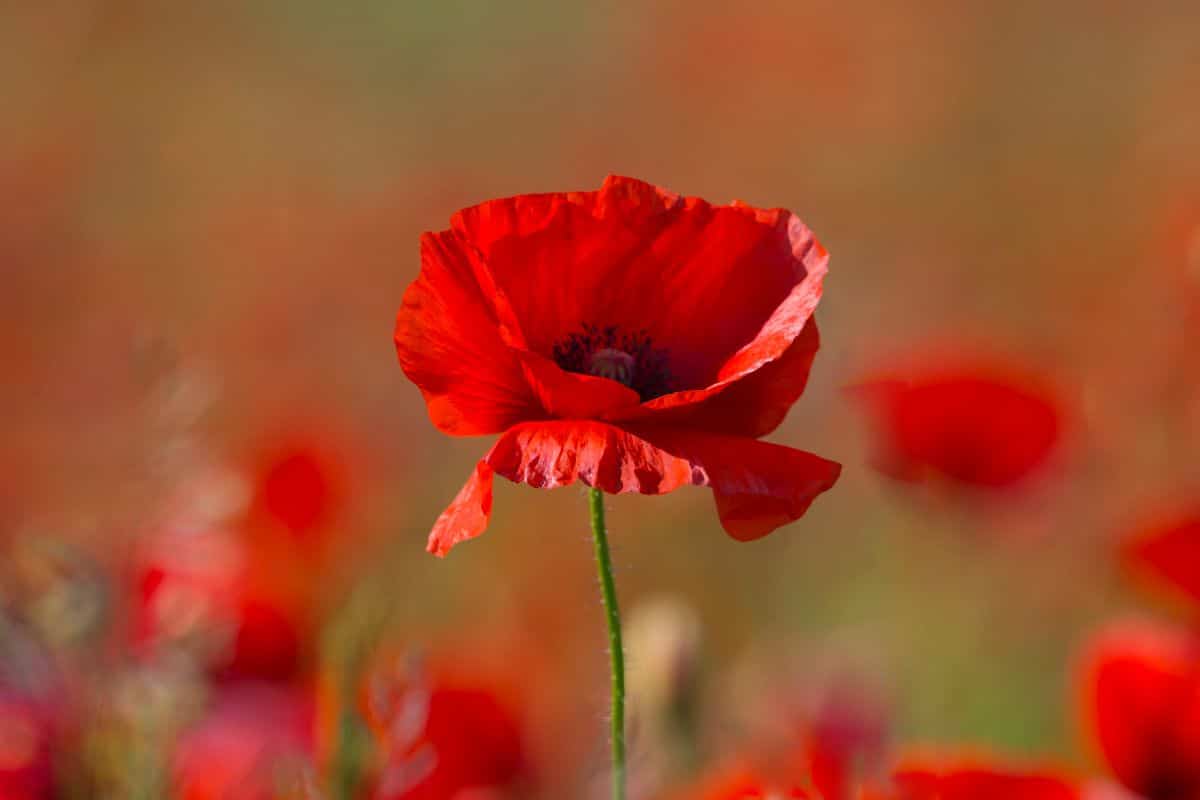
The exact length of the poppy bloom period depends on the specific type of poppy you plant. But in general, poppies do not blossom long. Usually, the flowers will fall within a few weeks of opening.
When to Plant Poppies
The best time to sow poppy seeds depends on where you live. If you have a warm climate, autumn is an appropriate time to spread your seeds in your garden beds or pots. But if you have a cold climate, spring is more suitable.
Ideal Growing Conditions for Poppies
Let’s talk about the growing conditions in which poppies thrive best, including their needs with respect to sun, soil and water.
How Much Sun Do Poppies Need?
To enjoy the largest number of healthy blossoms from your poppies each year, plant them where they receive a minimum of 6 hours of direct sun daily. Full sun is always preferable to even partial shade.
What Type of Soil is Right for Poppies?
Soil that is loamy and rich is ideal for poppies. Indeed, composting is wise when you plant them so that they have plenty of nutrition. Make sure that you use well-draining soil.
An ideal pH range for the soil is between 6.5 and 7.0.
How Much Water Do Poppies Need?
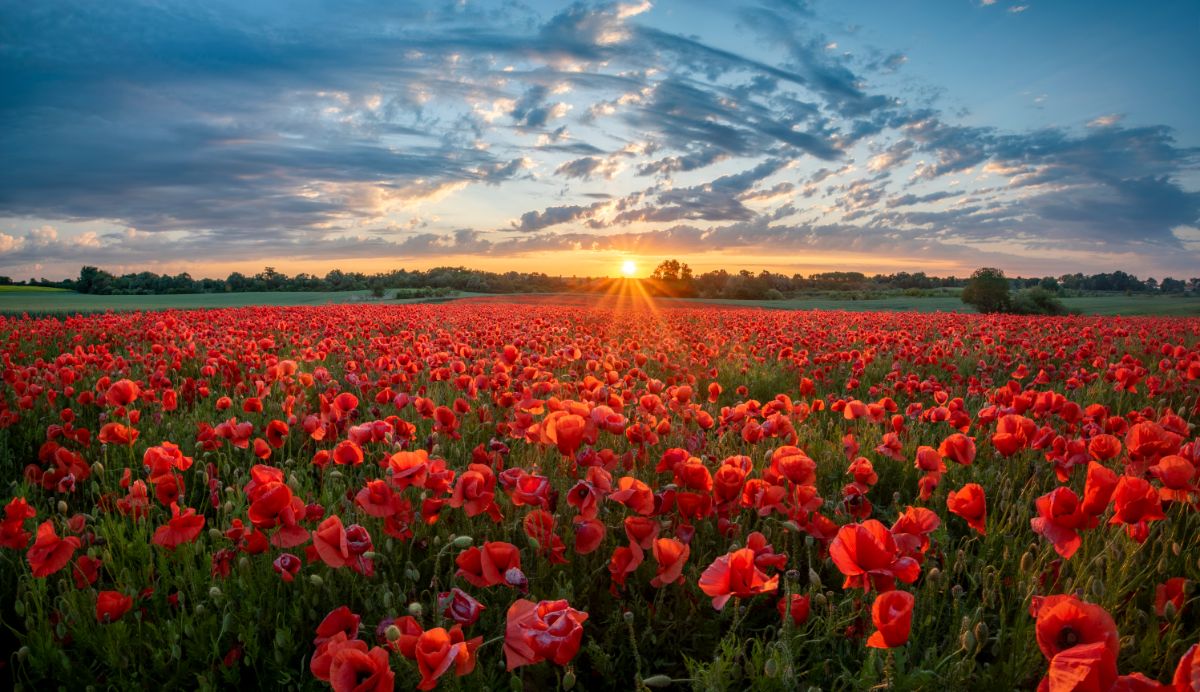
Most of the time, you only need to water poppies enough to moisten the soil when it starts drying out.
But when poppies are blooming, they may need a little extra water—around one inch weekly should be enough.
After poppies are done blooming, they go dormant. When your poppies are dormant, you can reduce the watering schedule significantly.
How to Plant Poppies
Now, let’s discuss planting poppies. Because it is not easy to successfully transplant poppies, these flowers are usually grown from seed. You will discover that growing poppies from seed is easy, no matter where you are planting them.
While you can start seeds indoors, you also can just sow them outside. If you choose to do the latter, the best time for it is autumn. But spring is also acceptable, so long as the last frost is still about a month ahead of you.
Container Planting
Here is how you can plant poppies in containers:
- Get a medium-sized pot and add drainage holes if they are lacking.
- Mix some compost into potting soil and add it to the pot.
- Sow the seeds. If you cover them at all, do so lightly.
- Use a spray bottle to lightly mist the soil surface. Do not let it dry out.
- Wait for the seeds to germinate.
- Choose a spot to keep the poppies over the long term. Full sun is great in most cases, but partial shade may be helpful if it gets super hot in the afternoon.
Ground Planting
Here are the steps to plant poppies in your garden beds:
- Begin by raking your soil. If you find any stones, you should remove them.
- Spread poppy seeds on the ground. Give them each about a foot of space.
- Get some soil from nearby and spread it across the top. You should only use a very thin layer.
- Wait for the seeds to germinate.
How to Care for Poppies
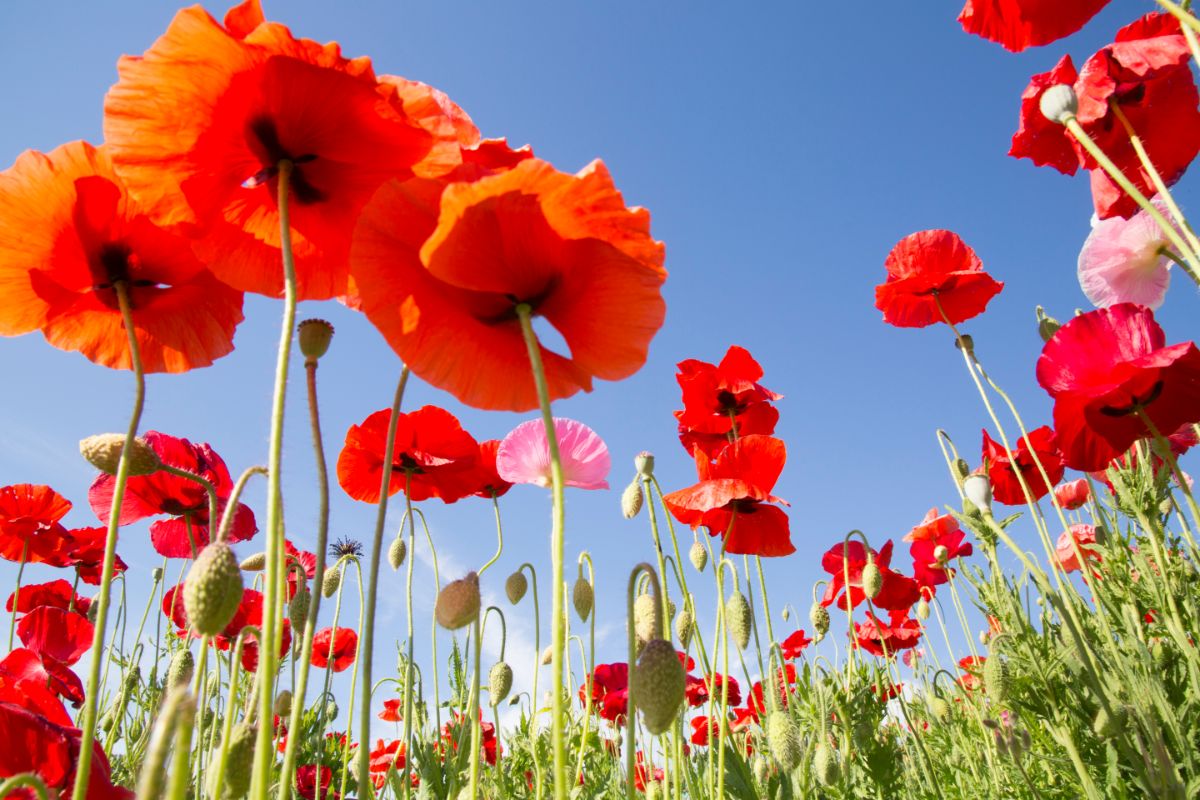
Now you know how to grow poppies. But how do you take care of them? Let’s talk about fertilizing, mulching, and other care your puppies might require.
How to Fertilize Poppies
You will get the prettiest poppies if you plant them in well-prepared soil. You can add compost, manure, or other organic amendments to your soil, or you can try purchasing a liquid fertilizer instead.
Liquid fertilizers that can work well for poppies include 23-19-17 or 20-20-20. Try applying it bi-weekly. If you do not want to spend that much time fertilizing, you could instead go for a slow-release product.
How to Mulch Poppies
It can sometimes be useful to use some mulch when you are growing your poppies if you are having problems with weeds. But the thing to keep in mind is that you cannot germinate poppy seeds successfully if there is too much on top of them blocking the sun. That is why we only cover them with a thin layer of dirt.
Mulch can cause the same problems as too much dirt on top of poppy seeds, interfering with germination and growth.
That is why you should not mulch right after you sow your seeds. But after the seeds have germinated and the poppies have begun growing, you can add a bit of mulch for weed prevention purposes.
How to Stake Poppies
Many types of poppies do not need any sort of support since they are not that tall, nor are their blossoms heavy.
But some types of tall poppies can flop over without support, especially if they are not in a sheltered part of your garden. For those types of poppies, you should consider staking.
How to Prune Poppies
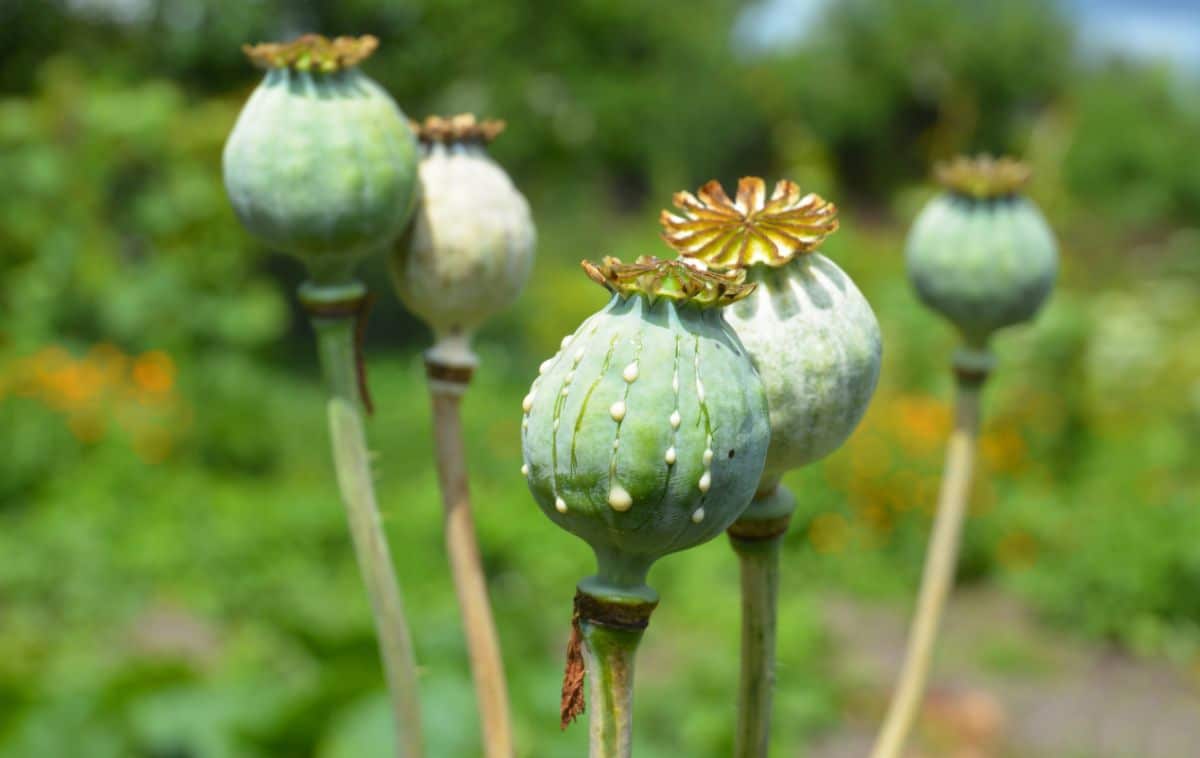
Now you know about fertilizing, mulching and staking poppies. What about pruning? We have two topics to talk about in this category: cutting back poppies after their season, and deadheading them.
When to Cut Back Poppies
Once your poppies wilt and the foliage blackens, it will become an eyesore. So, you will probably want to cut back your poppies come fall to clean up the appearance of your yard.
How to Deadhead Poppies
In most cases, it is unnecessary to deadhead your poppies after their flowers wilt. Doing so will not make them bloom for a second time during the season.
In fact, deadheading your poppies may be undesirable, depending on what types of poppies you have and whether you want to do something with their seed pods. Some poppy seed pods can be quite attractive (like those of the Flanders poppy), so you can collect them for floral arrangements or crafts.
Now, there are poppy cultivars that self-seed. Oriental poppies are one example.
That is great if you want your poppies to spread. Since Oriental poppies are perennials, they will come back for a few years, but they will also be seeding new plants along the way. That means your poppies will become more abundant from year to year if you let them.
But if you think they are going to be too abundant, you will want to deadhead to prevent the self-seeding.
Are Poppies Vulnerable to Diseases or Pests?
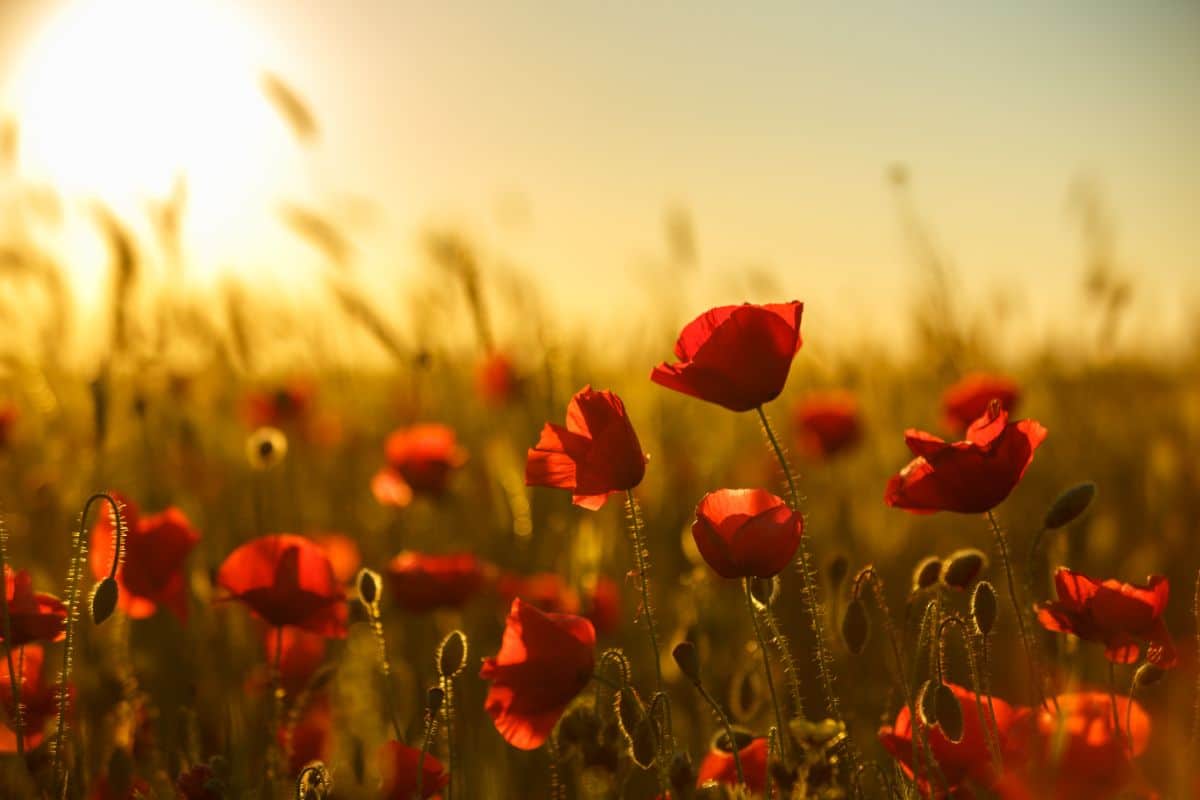
Poppies usually do not succumb to diseases or pest infestations, but they are possible. Some pests that sometimes cause problems for poppies include aphids, Hoplia beetles, spittlebugs and true bugs. On the bright side, it is unlikely that you will have any issues with slugs or snails.
Some diseases that may sometimes affect poppies include downy mildew, botrytis blight, powdery mildew, rhizoctonia root, and tomato spotted wilt virus.
Poppies are more likely to become diseased if they are in soggy soil that is not draining effectively, and/or they do not have enough room to breathe among your other plants. So, be sure and plant them where they get plenty of airflow. Keep soil moist, but not soggy.
How to Transplant Poppies
It is possible to transplant your perennial poppies. Horticulture Magazine writes, “Oriental poppies (Papaver orientale)—the type with large, showy spring flowers—are best transplanted in late summer, when they are not actively growing. They have long tap roots that can make moving them a little challenging. The larger the plant, the longer the taproot, so you may have the best success with a smaller plant.”
Here are the basic steps for transplanting a poppy:
- Use a shovel to cut down into the soil around your plant, making a circle. Do your best to not damage any of the roots. After you have completed the circle, try and get the shovel down underneath the tap root. Use the shovel to gently pry the taproot loose.
- Lift the plant out of the ground and shake out excess soil.
- Make a new hole for your plant where you want it to go. Insert it and backfill the soil.
- Water the soil often enough that it stays moist after transplanting. Once a month goes by, you can reduce the watering schedule.
Note: The roots of a poppy can dry out easily when you are transplanting. It is best to have the new hole ready to go before you pull out the poppy from the old hole. But if there is a delay, covering the roots temporarily with some damp soil should prevent any issues.
How to Propagate Poppies with Cuttings
Did you know you can also propagate poppies by taking cuttings? Here is how it works.
- Use a trowel to dig down around a poppy plant, and then lift up on the root ball from below.
- You will now have the roots of the poppy exposed. Using a knife, take a cutting of the roots.
- Now, slice up the cutting into smaller pieces. Each piece should be about two and a half centimeters in length.
- Fill a seed tray with compost.
- Insert the root pieces into the compost. The thicker end of each piece should be pointed upwards.
- Put grit on top.
- Water your cuttings.
- After a time, you should see the root cuttings forming shoots.
- You are now free to move the new poppy plants to their permanent home.
Remember, if you have been doing this process indoors, you are going to need to harden your poppies before making them permanent outdoor residents.
Recommended Companion Plants for Poppies

Poppies are great for companion planting, as they look beautiful with anything, and may help to deter some unwanted pests. Here are a few ideas:
- Daisies: These sun-loving plants can thrive near poppies, and can add to the cheerful hues in your garden.
- Goldenrods: Another plant that flourishes in the full sun that can look beautiful next to poppies is goldenrod.
- Coneflowers: These perennials make lovely drought-tolerant companions for your poppies.
- Dahlias: These plants, like poppies, like lots of sunlight and well-drained soil. The stunning flowers come in many colors, and look lovely next to poppies.
Frequently Asked Questions About Growing Poppies
Happily, most animals leave poppies alone, and even slugs and snails are not fans. So, if something is eating your poppies, it is probably an insect of some kind.
Goldenrods, dahlia, and coneflowers are a few ideas for poppy companion planting.
Yes, poppies are toxic to cats and dogs. When your pet is running around your yard, be sure to supervise so that they do not consume any poppies. If it is hard to stop your pet from trying to eat poppies, this may not be suitable for your yard.
You might wonder whether it is legal to grow poppies in your yard at all, considering that poppies could be used to manufacture opium.
It is certainly not legal to make opium, but it is legal to grow poppies at home.
This policy might initially sound lax, but it isn’t. Anyone who wants to sell opium or heroin in the US is going to have an easier time just importing it to sell rather than going to the trouble of growing poppies and manufacturing opium. It is not easy to do, nor is it cost-effective.
So, feel free to grow poppies. No one is going to care. In a lot of locations, they grow as wildflowers, so sometimes they will end up in your yard accidentally.
Where to Buy Poppies
Poppies may be short-lived each season, but during the weeks they are in bloom, they bring delightful warm colors to your yard and garden. To shop perennial poppy varieties now, click the link below.

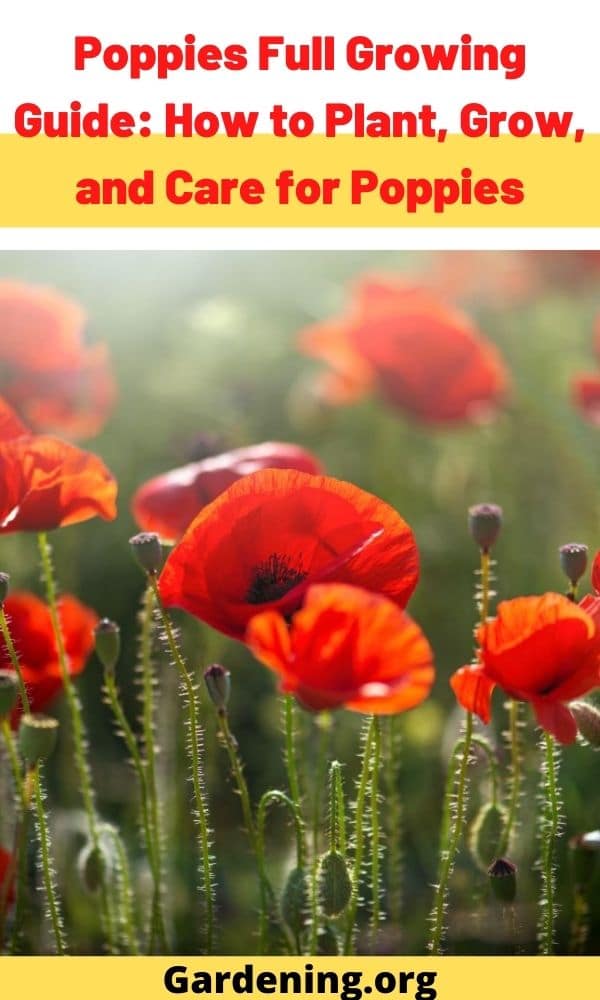
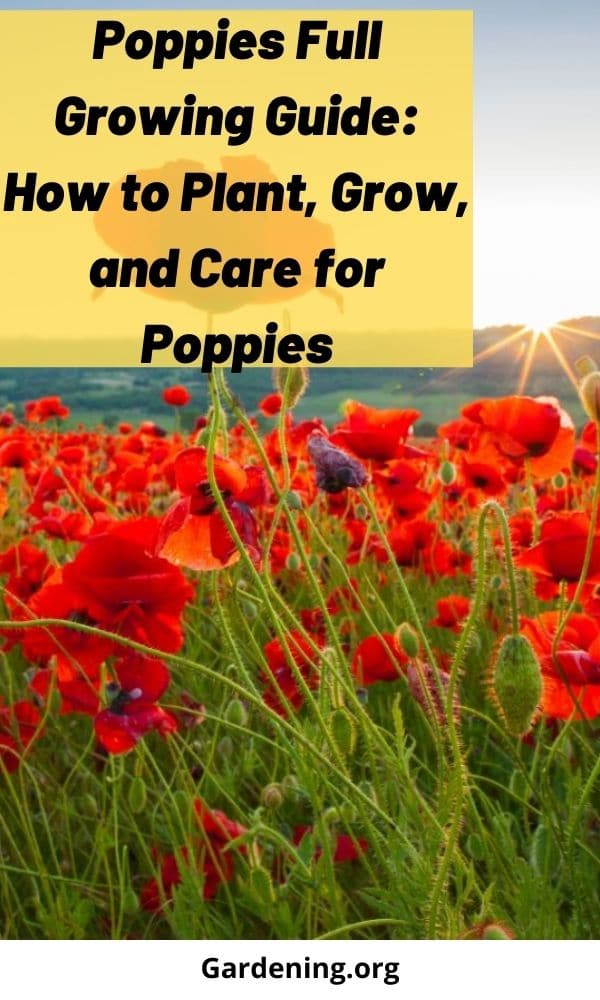

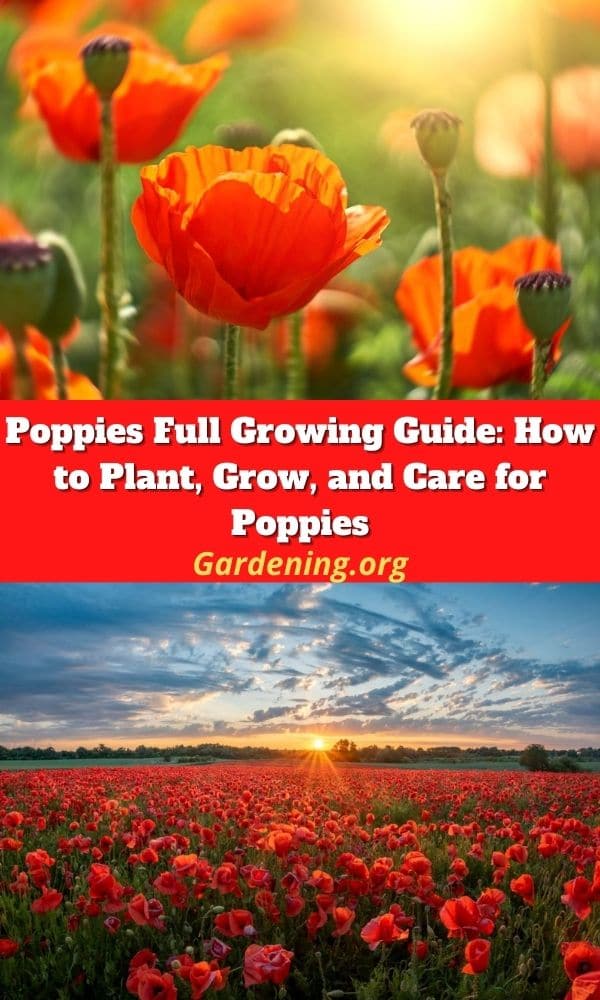
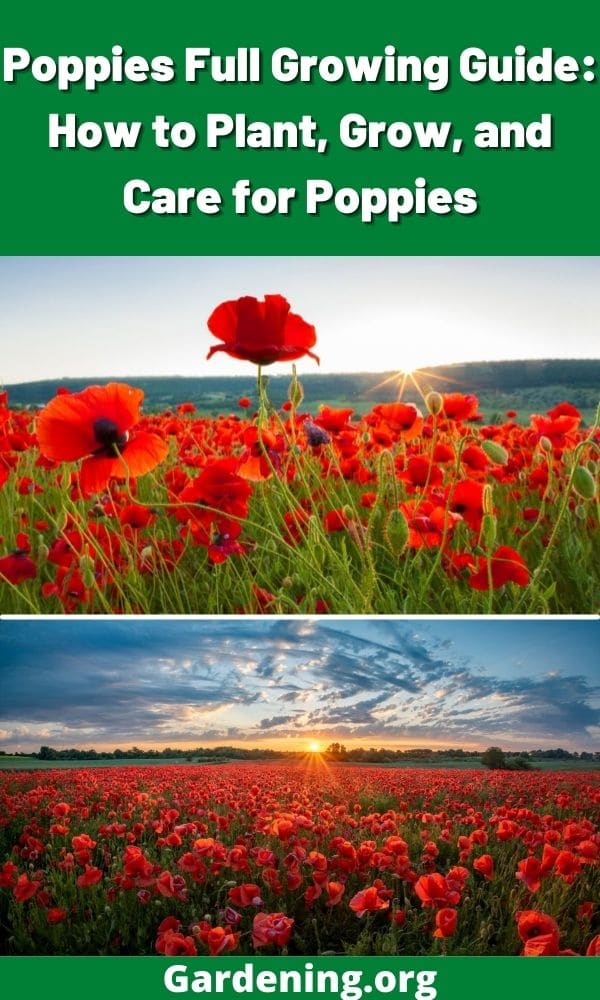

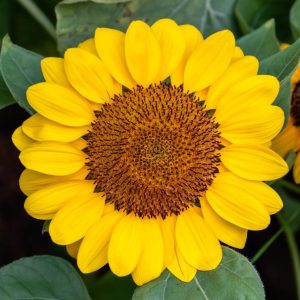
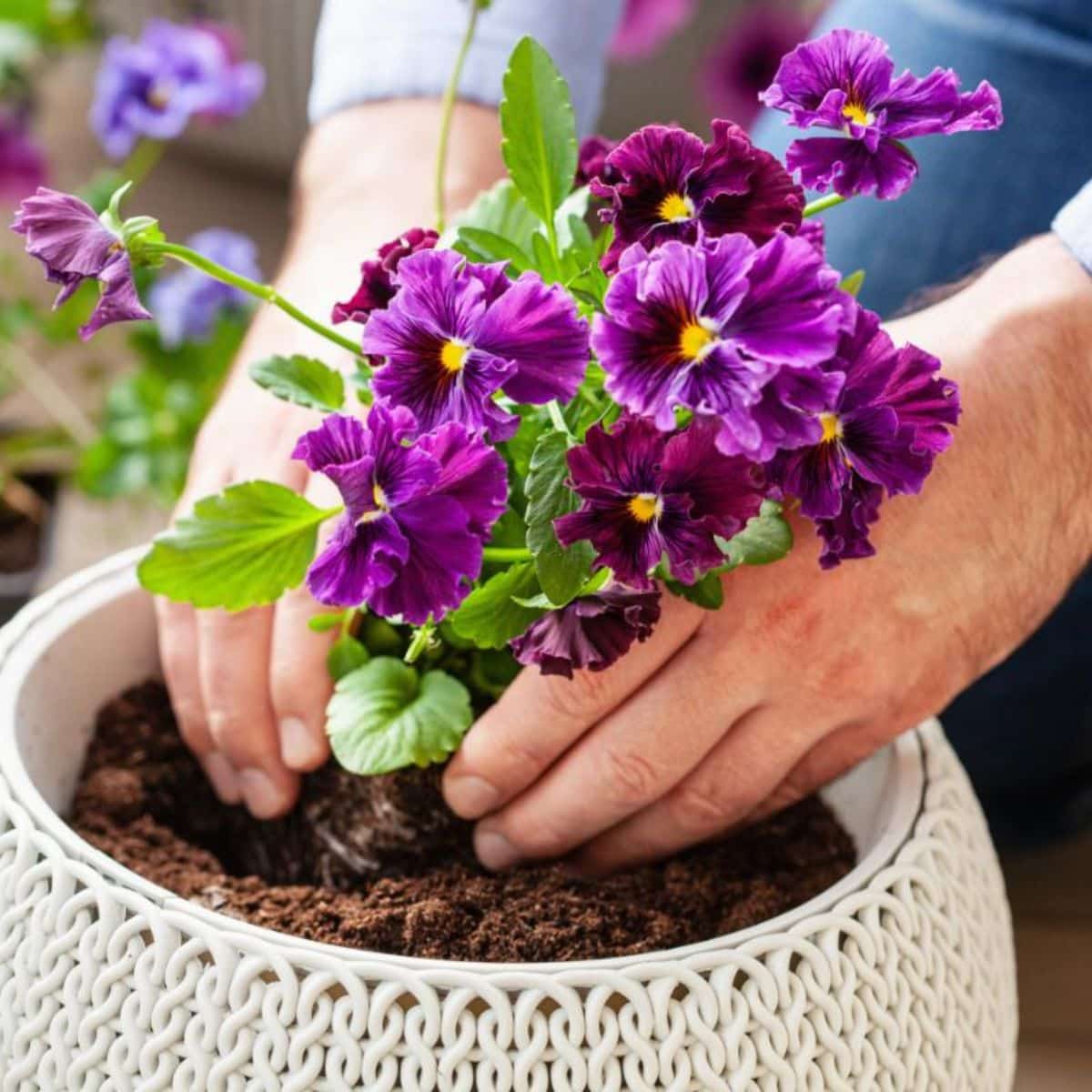
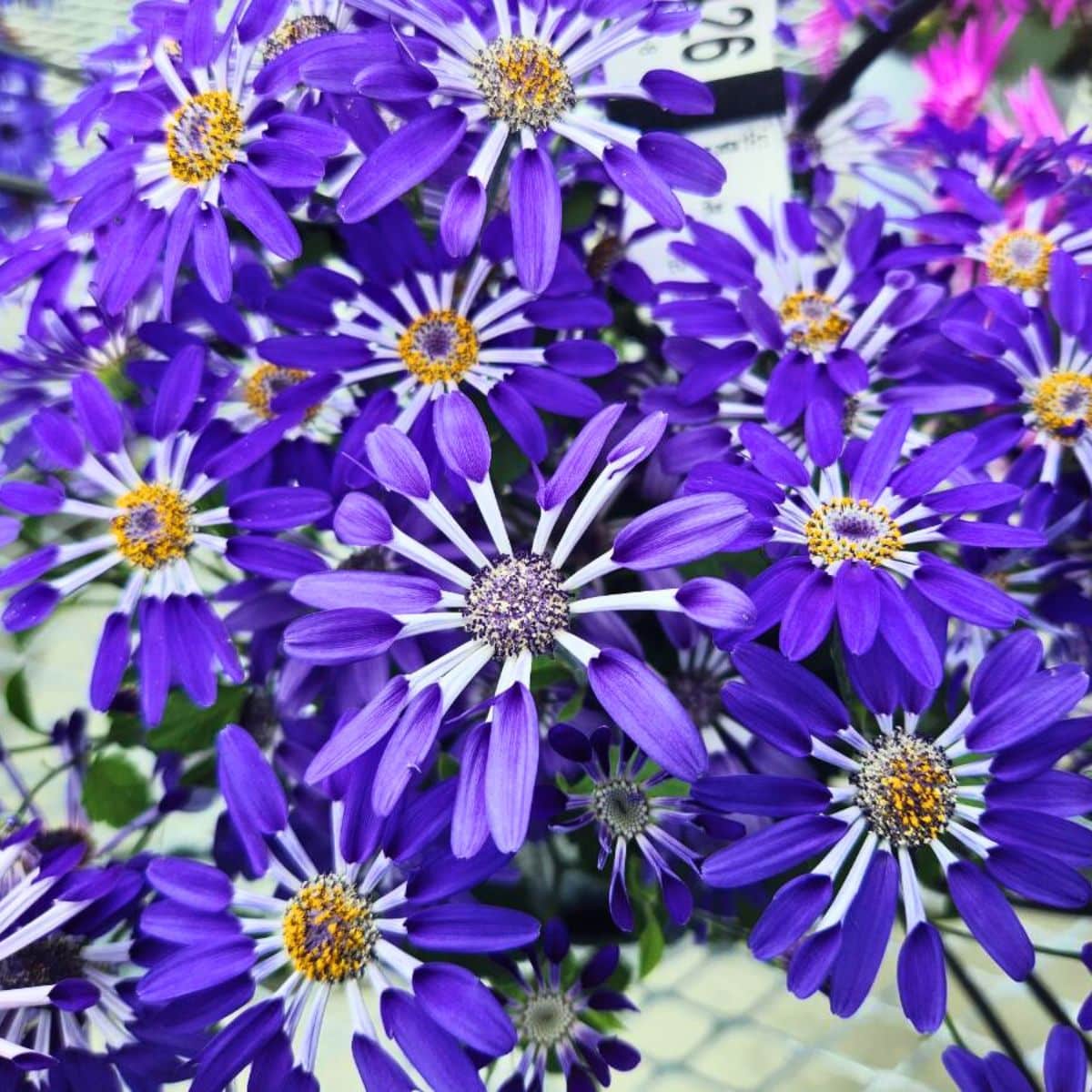
Leave a Reply